A Systematic Review of Contemporary Challenges and Debates on Chinese Food Security: Integrating Priorities, Trade-Offs, and Policy Pathways
Abstract
1. Introduction
- (i)
- Debate one, self-sufficiency and trade dependencies: This debate examines the tension between self-sufficiency imperatives and growing trade dependencies, probing the implications of China’s evolving stance on international trade for domestic food security paradigms. This discussion highlights how reliance on imports for certain commodities interacts with national strategies aimed at achieving self-reliance in agricultural products.
- (ii)
- Debate two, agricultural intensification and environmental sustainability: This debate navigates and highlights the challenge of increasing productivity while maintaining ecological resilience. This section underscores the trade-offs between maximizing yields through intensive farming practices and mitigating environmental degradation caused by the overuse of resources such as water, soil, and fertilizers.
- (iii)
- Debate three, small-scale farming vs. large-scale agribusiness models: This debate explores the socio-economic impacts of different agricultural production approaches. It considers how these models affect rural livelihoods, income disparities, and overall efficiency in meeting China’s growing food demands.
- (iv)
- Debate four, climate change resilience in agriculture: This debate focuses on strategies to enhance climate change resilience in China’s agricultural sector, acknowledging threats posed by climate variability and extreme weather events. This section evaluates adaptive measures such as crop diversification, technological innovations, and policy interventions aimed at safeguarding agricultural productivity under changing climatic conditions.
- (v)
- Debate five, food safety regulations and consumer concerns: This debate discusses the importance of robust regulatory frameworks and initiatives to empower consumers. It also highlights initiatives designed to empower consumers through better transparency in supply chains and improved access to information about food quality standards.
2. Methodology
3. Results and Discussion
3.1. Self-Sufficiency and Trade Dependency
3.2. Agricultural Intensification and Environmental Sustainability
3.3. Small-Scale Farming and Large-Scale Agribusiness
3.4. Climate Change Resilience
3.5. Food Safety Regulations and Consumer Concerns
4. Conclusion and Policy Implications
Author Contributions
Funding
Institutional Review Board Statement
Informed Consent Statement
Data Availability Statement
Conflicts of Interest
References
- Van Dijk, M.; Morley, T.; Rau, M.L.; Saghai, Y. A meta-analysis of projected global food demand and population at risk of hunger for the period 2010–2050. Nat. Food 2021, 2, 494–501. [Google Scholar] [CrossRef] [PubMed]
- Wood, A.; Queiroz, C.; Deutsch, L.; González-Mon, B.; Jonell, M.; Pereira, L.; Sinare, H.; Svedin, U.; Wassénius, E. Reframing the Local–Global Food Systems Debate through a Resilience Lens. Nat. Food 2023, 4, 22–29. [Google Scholar] [CrossRef] [PubMed]
- Rehman, A.; Batool, Z.; Ma, H.; Alvarado, R.; Oláh, J. Climate Change and Food Security in South Asia: The Importance of Renewable Energy and Agricultural Credit. Humanit. Soc. Sci. Commun. 2024, 11, 342. [Google Scholar] [CrossRef]
- Urom, C.; Guesmi, K.; Abid, I.; Enwo-Irem, I.N. Co-Inventions, Uncertainties and Global Food Security. Environ. Econ. Policy Stud. 2022. [Google Scholar] [CrossRef]
- Lee, C.C.; Zeng, M.; Luo, K. How does climate change affect food security? Evidence from China. Environ. Impact Assess. Rev. 2024, 104, 0195–9255. [Google Scholar] [CrossRef]
- World Bank. Food Security Updates: World Bank Response to Rising Food Security. 2024. Available online: https://www.worldbank.org/en/topic/agriculture/brief/food-security-update (accessed on 28 August 2024).
- Abbott, P.; de Battisti, A.B. Recent Global Food Price Shocks: Causes, Consequences and Lessons for African Governments and Donors. J. Afr. Econ. 2011, 20 (Suppl. 1), i12–i62. [Google Scholar] [CrossRef]
- Koren, O.; Bagozzi, B.E. From Global to Local, Food Insecurity Is Associated with Contemporary Armed Conflicts. Food Secur. 2016, 8, 999–1010. [Google Scholar] [CrossRef]
- Li, C.; Bremer, P.; Harder, M.K.; Lee, M.S.; Parker, K.; Gaugler, E.C.; Mirosa, M. A systematic review of food loss and waste in China: Quantity, impacts and mediators. J. Environ. Manag. 2022, 303, 114092. [Google Scholar] [CrossRef]
- Gatto, A.; Chepeliev, M. Global Food Loss and Waste Estimates Show Increasing Nutritional and Environmental Pressures. Nat. Food 2024, 5, 136–147. [Google Scholar] [CrossRef]
- Wang, X.; Dou, Z.; Feng, S.; Zhang, Y.; Ma, L.; Zou, C.; Bai, Z.; Lakshmanan, P.; Shi, X.; Liu, D.; et al. Global Food Nutrients Analysis Reveals Alarming Gaps and Daunting Challenges. Nat. Food 2023, 4, 1007–1017. [Google Scholar] [CrossRef]
- Dong, L.; Huang, Z. Some evidence and new insights for feedback loops of human-nature interactions from a holistic Earth perspective. J. Clean. Prod. 2023, 432, 139667. [Google Scholar] [CrossRef]
- Luo, M.; Cai, J.; Zeng, Z.; Zheng, Y.; Lin, T. Development and practices of nature-based solutions in China. Nat.-Based Solut. 2024, 5, 100109. [Google Scholar] [CrossRef]
- Luque-Moya, G. Toward a Harmonic Relationship between Humans and Nature: A Humanist Reinterpretation of Early Confucian Philosophy. Asian Stud. 2023, 11, 129–147. [Google Scholar] [CrossRef]
- Coomes, O.T.; Barham, B.L.; MacDonald, G.K.; Ramankutty, N.; Chavas, J.-P. Leveraging Total Factor Productivity Growth for Sustainable and Resilient Farming. Nat. Sustain. 2019, 2, 22–28. [Google Scholar] [CrossRef]
- Sheng, Y.; Tian, X.; Qiao, W.; Peng, C. Measuring Agricultural Total Factor Productivity in China: Pattern and Drivers over the Period of 1978–2016. Aust. J. Agric. Resour. Econ. 2020, 64, 82–103. [Google Scholar] [CrossRef]
- Ortiz-Bobea, A.; Ault, T.R.; Carrillo, C.M.; Chambers, R.G.; Lobell, D.B. Anthropogenic Climate Change Has Slowed Global Agricultural Productivity Growth. Nat. Clim. Change 2021, 11, 306–312. [Google Scholar] [CrossRef]
- Hou, M.; Zhong, S.; Xi, Z.; Yao, S. Does Large-Scale Ecological Restoration Threaten Food Security in China? A Moderated Mediation Model. Ecol. Indic. 2022, 143, 109372. [Google Scholar] [CrossRef]
- Cao, S.; Liu, Z.; Li, W.; Xian, J. Balancing Ecological Conservation with Socioeconomic Development. Ambio 2021, 50, 1117–1122. [Google Scholar] [CrossRef]
- Wolf, C.; Ripple, W.J.; Crist, E. Human Population, Social Justice, and Climate Policy. Sustain. Sci. 2021, 16, 1753–1756. [Google Scholar] [CrossRef]
- Ruijer, E.; Porumbescu, G.; Porter, R.; Piotrowski, S. Social Equity in the Data Era: A Systematic Literature Review of Data-Driven Public Service Research. Public Adm. Rev. 2023, 83, 316–332. [Google Scholar] [CrossRef]
- Woodhill, J.; Kishore, A.; Njuki, J.; Jones, K.; Hasnain, S. Food Systems and Rural Wellbeing: Challenges and Opportunities. Food Secur. 2022, 14, 1099–1121. [Google Scholar] [CrossRef] [PubMed]
- Bezner Kerr, R.; Postigo, J.C.; Smith, P.; Cowie, A.; Singh, P.K.; Rivera-Ferre, M.; der Pahlen, M.C.T.-V.; Campbell, D.; Neufeldt, H. Agroecology as a Transformative Approach to Tackle Climatic, Food, and Eco systemic Crises. Curr. Opin. Environ. Sustain. 2023, 62, 101275. [Google Scholar] [CrossRef]
- Karunathilake, E.M.B.M.; Le, A.T.; Heo, S.; Chung, Y.S.; Mansoor, S. The Path to Smart Farming: Innovations and Opportunities in Precision Agriculture. Agriculture 2023, 13, 1593. [Google Scholar] [CrossRef]
- Luo, N.; Olsen, T.; Liu, Y.; Zhang, A. Reducing Food Loss and Waste in Supply Chain Operations. Transp. Res. Part E Logist. Transp. Rev. 2022, 162, 102730. [Google Scholar] [CrossRef]
- Nikolicic, S.; Kilibarda, M.; Maslaric, M.; Mircetic, D.; Bojic, S. Reducing Food Waste in the Retail Supply Chains by Improving Efficiency of Logistics Operations. Sustainability 2021, 13, 6511. [Google Scholar] [CrossRef]
- Li, S.; Zhang, Y. More Unequal Food Distribution in Low-Income Countries Exacerbates Global Hunger Risk. Sustain. Prod. Consum. 2024, 46. [Google Scholar] [CrossRef]
- Clapp, J.; Moseley, W.G.; Burlingame, B.; Termine, P. Viewpoint: The Case for a Six-Dimensional Food Security Framework. Food Policy 2022, 106, 102164. [Google Scholar] [CrossRef]
- Rabbi, M.F.; Hasan, M.; Kovács, S. Food Security and Transition towards Sustainability. Sustainability 2021, 13, 12433. [Google Scholar] [CrossRef]
- Mc Carthy, U.; Uysal, I.; Badia-Melis, R.; Mercier, S.; O’Donnell, C.; Ktenioudaki, A. Global Food Security–Issues, Challenges and Technological Solutions. Trends Food Sci. Technol. 2018, 77, 11–20. [Google Scholar] [CrossRef]
- Liu, Y.; Zhou, Y. Reflections on China’s food security and land use policy under rapid urbanization. Land Use Policy 2021, 109, 105699. [Google Scholar] [CrossRef]
- Ghose, B. Food security and food self-sufficiency in China: From past to 2050. Food Energy Secur. 2014, 3, 86–95. [Google Scholar] [CrossRef]
- Christiansen, F. Food Security, Urbanization and Social Stability in China. J. Agrar. Change 2009, 9, 548–575. [Google Scholar] [CrossRef]
- Carter, C.A.; Zhong, F.; Zhu, J. Advances in Chinese agriculture and its global implications. Appl. Econ. Perspect. Policy 2012, 34, 1–36. [Google Scholar] [CrossRef]
- Zhou, Y.; Guo, L.; Liu, Y. Land consolidation boosting poverty alleviation in China: Theory and practice. Land Use Policy 2019, 82, 339–348. [Google Scholar] [CrossRef]
- Zhou, Y.; Li, X.; Liu, Y. Rural land system reforms in China: History, issues, measures and prospects. Land Use Policy 2020, 91, 104330. [Google Scholar] [CrossRef]
- Krusekopf, C.C. Diversity in land-tenure arrangements under the household responsibility system in China. China Econ. Rev. 2002, 13, 297–312. [Google Scholar] [CrossRef]
- Xu, H. The long-term health and economic consequences of improved property rights. J. Public Econ. 2021, 201, 104492. [Google Scholar] [CrossRef]
- Shen, J.; Cui, Z.; Miao, Y.; Mi, G.; Zhang, H.; Fan, M.; Zhang, C.; Jiang, R.; Zhang, W.; Li, H.; et al. Transforming agriculture in China: From solely high yield to both high yield and high resource use efficiency. Glob. Food Secur. 2013, 2, 1–8. [Google Scholar] [CrossRef]
- Cao, Y.; Cai, H.; Sun, S.; Gu, X.; Mu, Q.; Duan, W.; Zhao, Z. Effects of drip irrigation methods on yield and water productivity of maize in Northwest China. Agric. Water Manag. 2022, 259, 107227. [Google Scholar] [CrossRef]
- Wang, Y.; Chen, Y.; Li, Z. Escaping poverty: Changing characteristics of China’s rural poverty reduction policy and future trends. Humanit. Soc. Sci. Commun. 2024, 11, 694. [Google Scholar] [CrossRef]
- Fan, P.; Mishra, A.K.; Feng, S.; Su, M.; Hirsch, S. The impact of China’s new agricultural subsidy policy on grain crop acreage. Food Policy 2023, 118, 102472. [Google Scholar] [CrossRef]
- Lopez, R.A.; He, X.; De Falcis, E. What drives China’s new agricultural subsidies? World Dev. 2017, 93, 279–292. [Google Scholar] [CrossRef]
- Su, M.; Heerink, N.; Oosterveer, P.; Tan, T.; Feng, S. Impacts of China’s Minimum Grain Procurement Price Program on Agrochemical Use: A Household-Level Analysis. Agriculture 2021, 11, 910. [Google Scholar] [CrossRef]
- Shea, E.Y.P. Understanding China’s grain procurement policy from a perspective of optimization. China Econ. Rev. 2010, 21, 639–649. [Google Scholar] [CrossRef]
- Luo, Y.; Huang, D.; Li, D.; Wu, L. On farm storage, storage losses and the effects of loss reduction in China. Resour. Conserv. Recycl. 2020, 162, 105062. [Google Scholar] [CrossRef]
- Yu, M.; Chen, Z.; Long, Y.; Mansury, Y. Urbanization, land conversion, and arable land in Chinese cities: The ripple effects of high-speed rail. Appl. Geogr. 2022, 146, 102756. [Google Scholar] [CrossRef]
- Liu, J.; Fang, Y.; Wang, G.; Liu, B.; Wang, R. The aging of farmers and its challenges for labor-intensive agriculture in China: A perspective on farmland transfer plans for farmers’ retirement. J. Rural Stud. 2023, 100, 103013. [Google Scholar] [CrossRef]
- Liu, L.; Zheng, X.; Wei, X.; Kai, Z.; Xu, Y. Excessive Application of Chemical Fertilizer and Organophosphorus Pesticides Induced Total Phosphorus Loss from Planting Causing Surface Water Eutrophication. Sci. Rep. 2021, 11, 23015. [Google Scholar] [CrossRef]
- Zuo, L.; Zhang, Z.; Carlson, K.M.; MacDonald, G.K.; Brauman, K.A.; Liu, Y.; Zhang, W.; Zhang, H.; Wu, W.; Zhao, X.; et al. Progress towards Sustainable Intensification in China Challenged by Land-Use Change. Nat. Sustain. 2018, 1, 304–313. [Google Scholar] [CrossRef]
- Zhu, Y.; Li, Y.; Wang, Y.; Li, L. The impact of water and soil scarcity and pollution on industrial agglomeration: Evidence from China. Sustainability 2021, 13, 5428. [Google Scholar] [CrossRef]
- Dehkordi, M.M.; Nodeh, Z.P.; Dehkordi, K.S.; Khorjestan, R.R.; Ghaffarzadeh, M. Soil, air, and water pollution from mining and industrial activities: Sources of pollution, environmental impacts, and prevention and control methods. Results Eng. 2024, 23, 102729. [Google Scholar] [CrossRef]
- Heino, M.; Kinnunen, P.; Anderson, W.; Ray, D.K.; Puma, M.J.; Varis, O.; Siebert, S.; Kummu, M. Increased probability of hot and dry weather extremes during the growing season threatens global crop yields. Sci. Rep. 2023, 13, 3583. [Google Scholar] [CrossRef]
- Shi, W.; Wang, M.; Liu, Y. Crop yield and production responses to climate disasters in China. Sci. Total Environ. 2021, 750, 141147. [Google Scholar] [CrossRef]
- Fuglie, K. Climate Change Upsets Agriculture. Nat. Clim. Change 2021, 11, 294–295. [Google Scholar] [CrossRef]
- Lam, H.M.; Remais, J.; Fung, M.C.; Xu, L.; Sun, S.M. Food supply and food safety issues in China. Lancet 2013, 381, 2044–2053. [Google Scholar] [CrossRef]
- Wang, Y.; Ling, X.; Ma, C.; Liu, C.; Zhang, W.; Huang, J.; Peng, S.; Deng, N. Can China Get out of Soy Dilemma? A Yield Gap Analysis of Soybean in China. Agron. Sustain. Dev. 2023, 43, 47. [Google Scholar] [CrossRef]
- Lanz, B.; Dietz, S.; Swanson, T. The expansion of modern agriculture and global biodiversity decline: An integrated assessment. Ecol. Econ. 2018, 144, 260–277. [Google Scholar] [CrossRef]
- Zhang, Q.; Men, X.; Hui, C.; Ge, F.; Ouyang, F. Wheat yield losses from pests and pathogens in China. Agric. Ecosyst. Environ. 2022, 326, 107821. [Google Scholar] [CrossRef]
- Zhong, S.; Wang, M.; Zhu, Y.; Chen, Z.; Huang, X. Urban expansion and the urban–rural income gap: Empirical evidence from China. Cities 2022, 129, 103831. [Google Scholar] [CrossRef]
- Niu, Y.; Xie, G.; Xiao, Y.; Liu, J.; Zou, H.; Qin, K.; Wang, Y.; Huang, M. The story of grain self-sufficiency: China’s food security and food for thought. Food and Energy Security. Adv. Online Publ. 2021, 11, e344. [Google Scholar] [CrossRef]
- He, J.; Wang, S.; Heijungs, R.; Yang, Y.; Shu, S.; Zhang, W.; Xu, A.; Fang, K. Interprovincial food trade aggravates China’s land scarcity. Humanit. Soc. Sci. Commun. 2024, 11, 76. [Google Scholar] [CrossRef]
- Jiang, Y. China’s water scarcity. J. Environ. Manag. 2009, 90, 3185–3196. [Google Scholar] [CrossRef] [PubMed]
- Ren, Y.; Castro Campos, B.; Peng, Y.; Glauben, T. Nutrition transition with accelerating urbanization? Empirical evidence from rural China. Nutrients 2021, 13, 921. [Google Scholar] [CrossRef] [PubMed]
- Ma, G.; Peng, F.; Yang, W.; Yan, G.; Gao, S.; Zhou, X.; Qi, J.; Cao, D.; Zhao, Y.; Pan, W.; et al. The valuation of China’s environmental degradation from 2004 to 2017. Environ. Sci. Ecotechnol. 2021, 1, 100016. [Google Scholar] [CrossRef]
- Van Berkum, S. How trade can drive inclusive and sustainable food system outcomes in food deficit low-income countries. Food Secur. 2021, 13, 1541–1554. [Google Scholar] [CrossRef]
- Edelman, M.; Weis, T.; Baviskar, A.; Borras, S.M.; Holt-Giménez, E.; Kandiyoti, D.; Wolford, W. Introduction: Critical Perspectives on Food Sovereignty. J. Peasant. Stud. 2014, 41, 911–931. [Google Scholar] [CrossRef]
- Wittman, H. Food Sovereignty: An Inclusive Model for Feeding the World and Cooling the Planet. One Earth 2023, 6, 474–478. [Google Scholar] [CrossRef]
- Elobeid, A.; Carriquiry, M.; Dumortier, J.; Swenson, D.; Hayes, D.J. China-U.S. trade dispute and its impact on global agricultural markets, the U.S. economy, and greenhouse gas emissions. J. Agric. Econ. 2021, 72, 647–672. [Google Scholar] [CrossRef]
- Yin, H.; Chang, L.; Wang, S. The impact of China’s economic uncertainty on commodity and financial markets. Resour. Policy 2023, 84, 103779. [Google Scholar] [CrossRef]
- Jiang, Z.; Yoon, S.-M. Interdependence between foreign exchange rate and international reserves: Fresh evidence from China. Res. Int. Bus. Financ. 2024, 69, 102255. [Google Scholar] [CrossRef]
- Ahsan, D.; Brandt, U.S.; Faruque, H. Local agricultural practices to adapt with climate change: Is sustainability a priority? Curr. Res. Environ. Sustain. 2021, 3, 100065. [Google Scholar] [CrossRef]
- Ren, M.; Huang, C.; Wu, Y.; Deppermann, A.; Frank, S.; Havlík, P.; Zhu, Y.; Fang, C.; Ma, X.; Liu, Y.; et al. Enhanced food system efficiency is the key to China’s 2060 carbon neutrality target. Nat. Food 2023, 4, 552–564. [Google Scholar] [CrossRef] [PubMed]
- Yang, J.; Qiu, H.; Huang, J.; Rozelle, S. Fighting Global Food Price Rises in the Developing World: The Response of China and Its Effect on Domestic and World Markets. Agric. Econ. 2008, 39 (Suppl. 1), 453–464. [Google Scholar] [CrossRef]
- Kummu, M.; Kinnunen, P.; Lehikoinen, E.; Porkka, M.; Queiroz, C.; Röös, E.; Troell, M.; Weil, C. Interplay of Trade and Food System Resilience: Gains on Supply Diversity over Time at the Cost of Trade Independency. Glob. Food Secur. 2020, 24, 100360. [Google Scholar] [CrossRef]
- Zheng, C.; Jiang, Y.; Chen, C.; Sun, Y.; Feng, J.; Deng, A.; Song, Z.; Zhang, W. The Impacts of Conservation Agriculture on Crop Yield in China Depend on Specific Practices, Crops and Cropping Regions. Crop J. 2014, 2, 289–296. [Google Scholar] [CrossRef]
- Liu, R.; Pieniak, Z.; Verbeke, W. Consumers’ Attitudes and Behavior towards Safe Food in China: A Review. Food Control 2013, 33, 93–104. [Google Scholar] [CrossRef]
- Xie, W.; Zhu, A.; Ali, T.; Zhang, Z.; Chen, X.; Wu, F.; Huang, J.; Davis, K.F. Crop switching can enhance environmental sustainability and farmer incomes in China. Nature 2023, 616, 300–305. [Google Scholar] [CrossRef]
- Tong, R.; Wang, Y.; Zhu, Y.; Wang, Y. Does the Certification of Agriculture Products Promote the Adoption of Integrated Pest Management among Apple Growers in China? Environ. Sci. Pollut. Res. 2022, 29, 29808–29817. [Google Scholar] [CrossRef]
- Feng, X.; Tao, S.; Jinrui, G.; Hongguang, C.; Chunrong, Q.; Yubo, H.; Yang, Y.; Aixing, D.; Zhenwei, S.; Weijian, Z. Climate-Smart Agriculture Practice Promotes Sustainable Maize Production in Northeastern China: Higher Grain Yield While Less Carbon Footprint. Field Crops Res. 2023, 302. [Google Scholar] [CrossRef]
- Rehman, A.; Muhammad, F.; Dong, J.L.; Kadambot, H.M. Sustainable Agricultural Practices for Food Security and Ecosystem Services. Environ. Sci. Pollut. Res. 2022. [Google Scholar] [CrossRef]
- Xia, X.; Xian, X.; Ling, M. What Are the Determinants of Large-Scale Farming in China? China World Econ. 2017, 25, 93–108. [Google Scholar] [CrossRef]
- Kendall, H.; Naughton, P.; Clark, B.; Taylor, J.; Li, Z.; Zhao, C.; Yang, G.; Chen, J.; Frewer, L.J. Precision Agriculture in China: Exploring Awareness, Understanding, Attitudes and Perceptions of Agricultural Experts and End-Users in China. Adv. Anim. Biosci. 2017, 8, 703–707. [Google Scholar] [CrossRef]
- Yang, Y.; Lian, D.; Zhang, Y.; Wang, D.; Wang, J. Towards Sustainable Agricultural Development: Integrating Small-Scale Farmers in China Through Agricultural Social Services. J. Knowl. Econ. 2024, 15, 16575–16616. [Google Scholar] [CrossRef]
- Wilmsen, B.; Rogers, S.; van Hulten, A.; Yuefang, D. In the Shadow of State-Led Agrarian Reforms: Smallholder Pervasiveness in Rural China. Agric. Hum. Values 2024, 41, 75–90. [Google Scholar] [CrossRef]
- Ren, C.; Zhou, X.; Wang, C.; Guo, Y.; Diao, Y.; Shen, S.; Reis, S.; Li, W.; Xu, J.; Gu, B. Ageing Threatens Sustainability of Smallholder Farming in China. Nature 2023, 616, 96–103. [Google Scholar] [CrossRef]
- Jetté-Nantel, S.; Hu, W.; Liu, Y. Economies of Scale and Mechanization in Chinese Corn and Wheat Production. Appl. Econ. 2020, 52, 2751–2765. [Google Scholar] [CrossRef]
- Zhang, D.; Wang, H.; Lou, S. Research on Grain Production Efficiency in China’s Main Grain-Producing Areas from the Perspective of Grain Subsidy. Environ. Technol. Innov. 2021, 22, 101530. [Google Scholar] [CrossRef]
- Yu, T.; Mahe, L.; Li, Y.; Wei, X.; Deng, X.; Zhang, D. Benefits of Crop Rotation on Climate Resilience and Its Prospects in China. Agronomy 2022, 12, 436. [Google Scholar] [CrossRef]
- Ahmed, Z.; Gui, D.; Murtaza, G.; Yunfei, L.; Ali, S. An Overview of Smart Irrigation Management for Improving Water Productivity under Climate Change in Drylands. Agronomy 2023, 13, 2113. [Google Scholar] [CrossRef]
- Langridge, P.; Braun, H.; Hulke, B.; Ober, E.; Prasanna, B. Breeding Crops for Climate Resilience. Theor. Appl. Genet. 2021, 134, 1607–1611. [Google Scholar] [CrossRef]
- Xie, Y.; Shen, Q.; Li, F.; Ni, S.; Yu, J. Temperature Response of Plants and Heat Tolerance in Rice: A Review. Adv. Agron. 2023, 179, 135–203. [Google Scholar] [CrossRef]
- Wang, C.; Wang, X.; Jin, Z.; Müller, C.; Pugh, T.A.; Chen, A.; Wang, T.; Huang, L.; Zhang, Y.; Li, L.X.; et al. Occurrence of Crop Pests and Diseases Has Largely Increased in China since 1970. Nat. Food 2022, 3, 57–65. [Google Scholar] [CrossRef] [PubMed]
- Kapari, M.; Hlophe-Ginindza, S.; Nhamo, L.; Mpandeli, S. Contribution of smallholder farmers to food security and opportunities for resilient farming systems. Front. Sustain. Food Syst. 2023, 7, 1149854. [Google Scholar] [CrossRef]
- Liu, Y.; Xin, Z.; Sun, S.; Zhang, C.; Fu, G. Assessing Environmental, Economic, and Social Impacts of Inter-Basin Water Transfer in China. J. Hydrol. 2023, 625, 130008. [Google Scholar] [CrossRef]
- Kendall, H.; Clark, B.; Li, W.; Jin, S.; Jones, G.D.; Chen, J.; Taylor, J.; Li, Z.; Frewer, L.J. Precision agriculture technology adoption: A qualitative study of small-scale commercial “family farms” located in the North China Plain. Precis. Agric. 2022, 23, 319–351. [Google Scholar] [CrossRef]
- Ratnadass, A.; Fernandes, P.; Avelino, J.; Habib, R. Plant species diversity for sustainable management of crop pests and diseases in agroecosystems: A review. Agron. Sustain. Dev. 2012, 32, 273–303. [Google Scholar] [CrossRef]
- Zhu, S.; Sainju, U.P.; Zhang, S.; Tan, G.; Wen, M.; Dou, Y.; Yang, R.; Chen, J.; Zhao, F.; Wang, J. Cover cropping promotes soil carbon sequestration by enhancing microaggregate-protected and mineral-associated carbon. Sci. Total Environ. 2024, 908, 168330. [Google Scholar] [CrossRef]
- Hong, W.; Mao, J.; Wu, L.; Pu, X. Public Cognition of the Application of Blockchain in Food Safety Management—Data from China’s Zhihu Platform. J. Clean. Prod. 2021, 303, 127044. [Google Scholar] [CrossRef]
- Liu, Z.; Mutukumira, A.N.; Chen, H. Food Safety Governance in China: From Supervision to Coregulation. Food Sci. Nutr. 2019, 7, 4127–4139. [Google Scholar] [CrossRef]
- Zhou, X.; Pullman, M.; Xu, Z. The Impact of Food Supply Chain Traceability on Sustainability Performance. Oper. Manag. Res. 2022, 15, 93–115. [Google Scholar] [CrossRef]
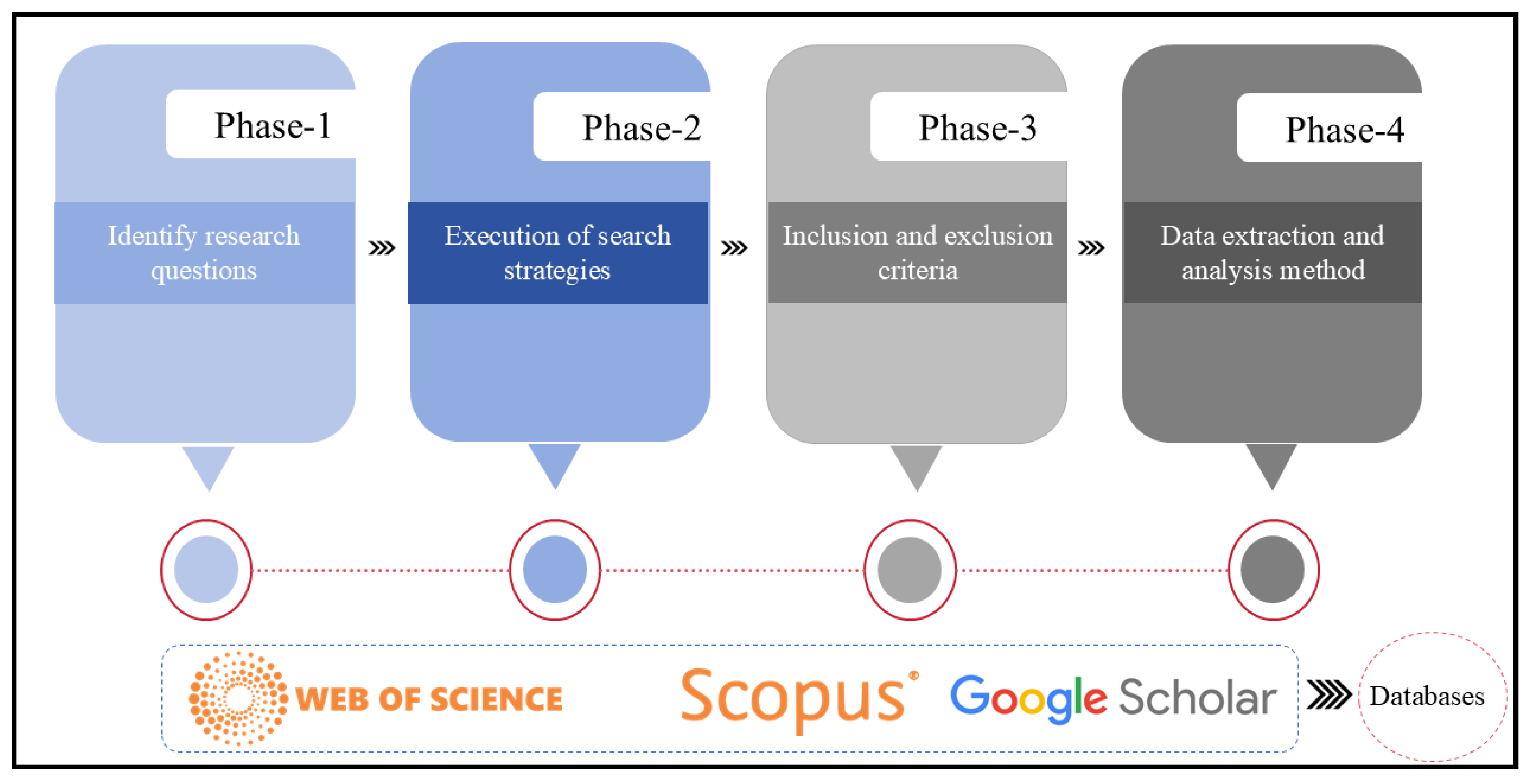
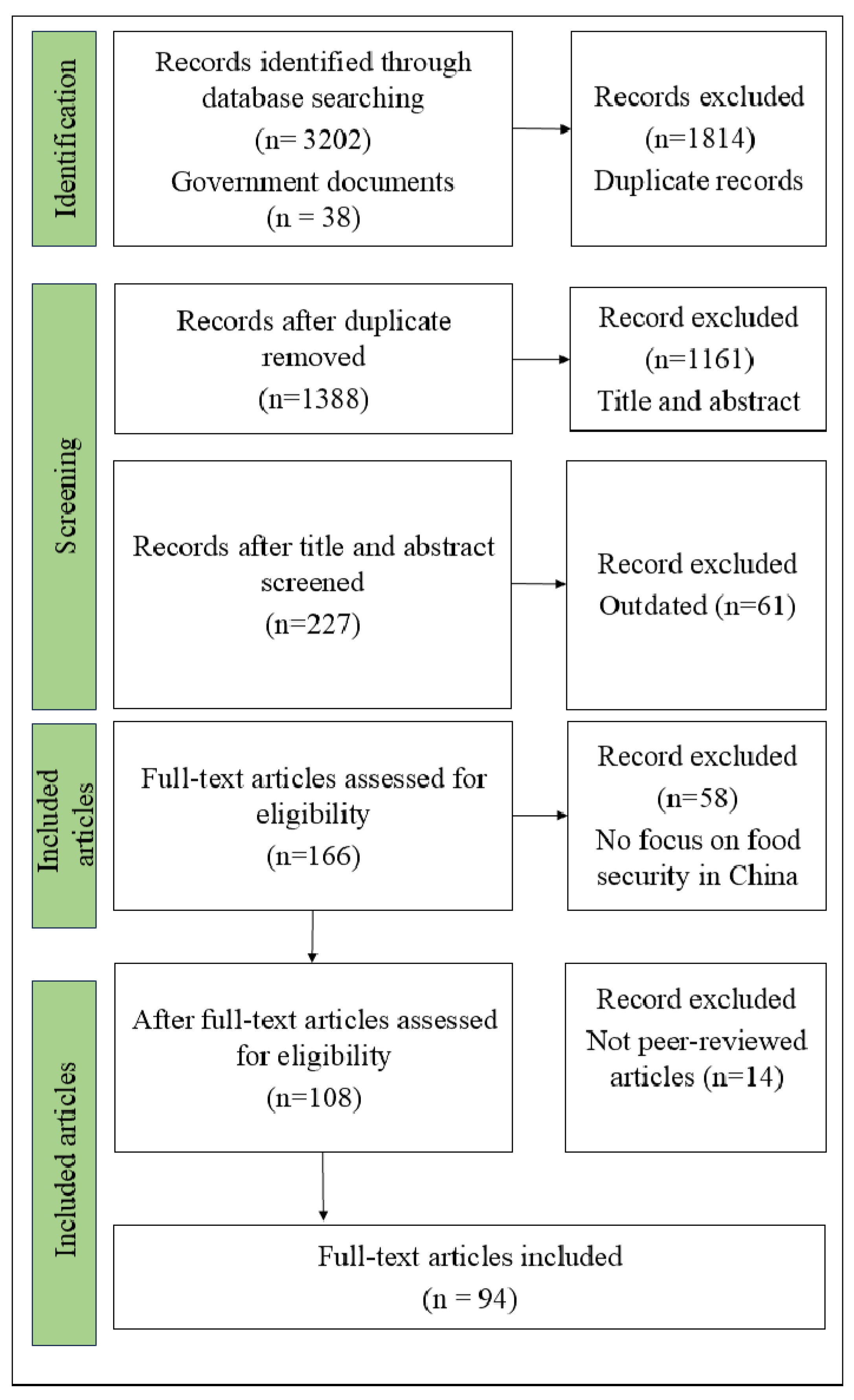
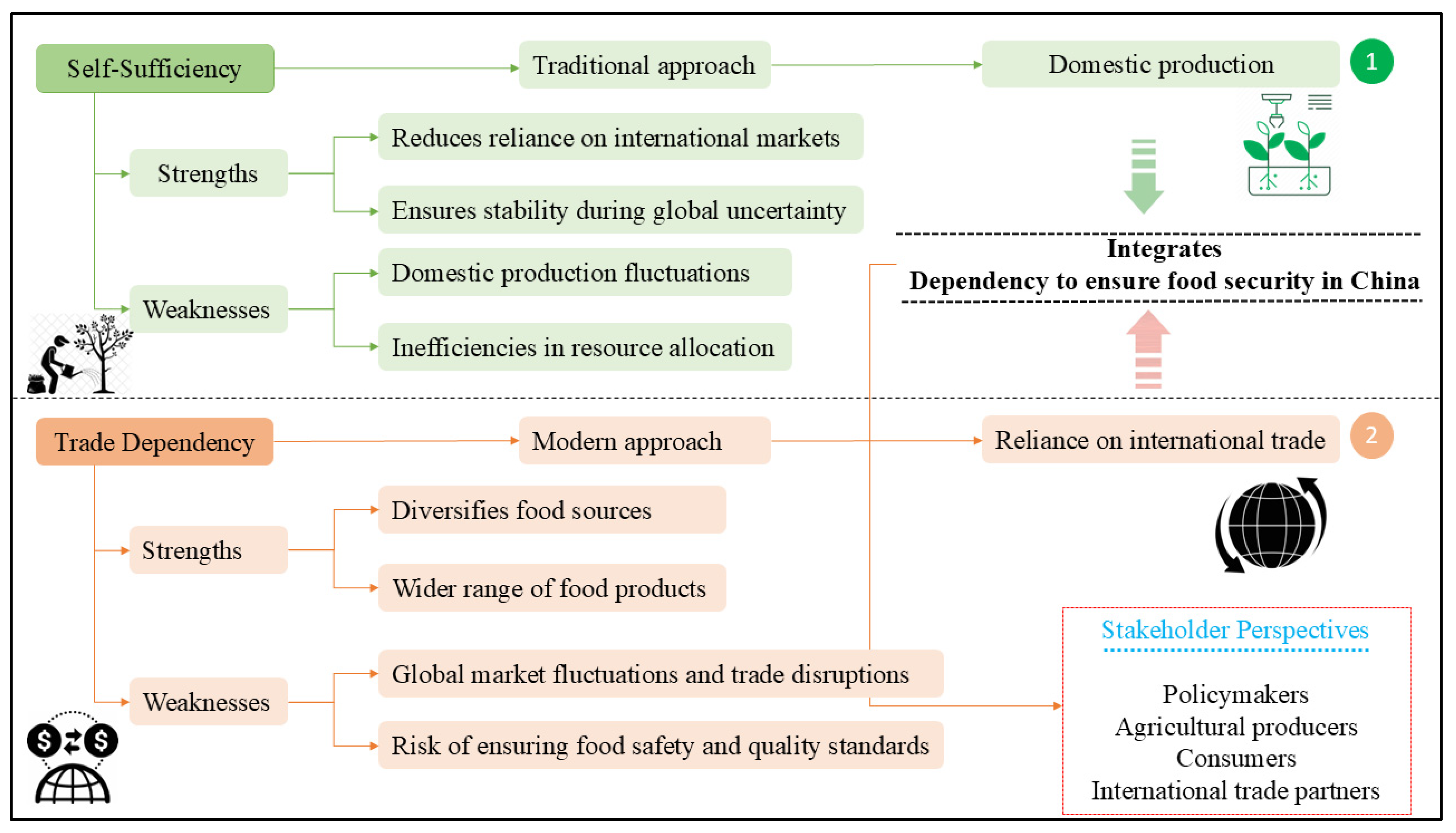
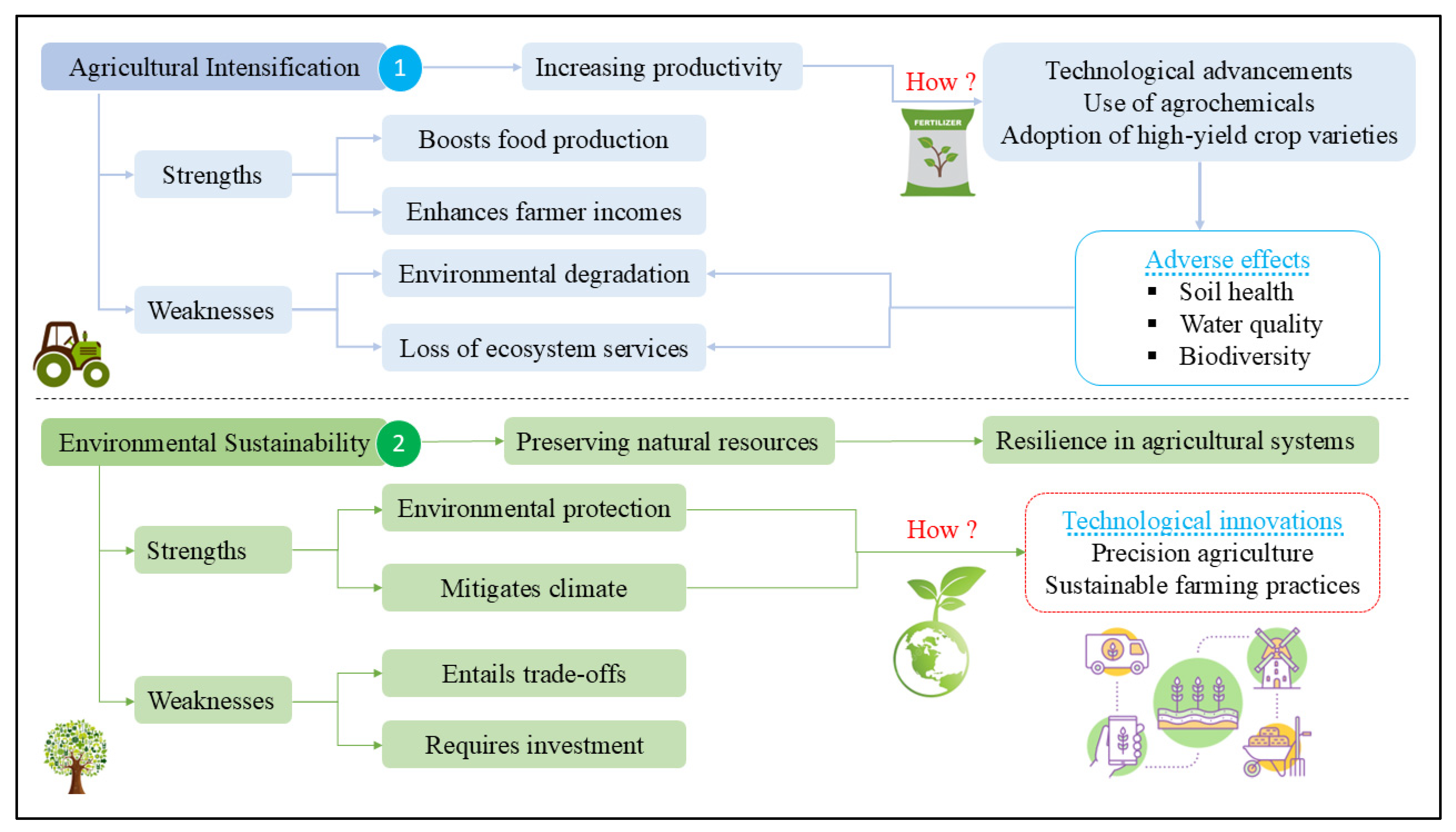
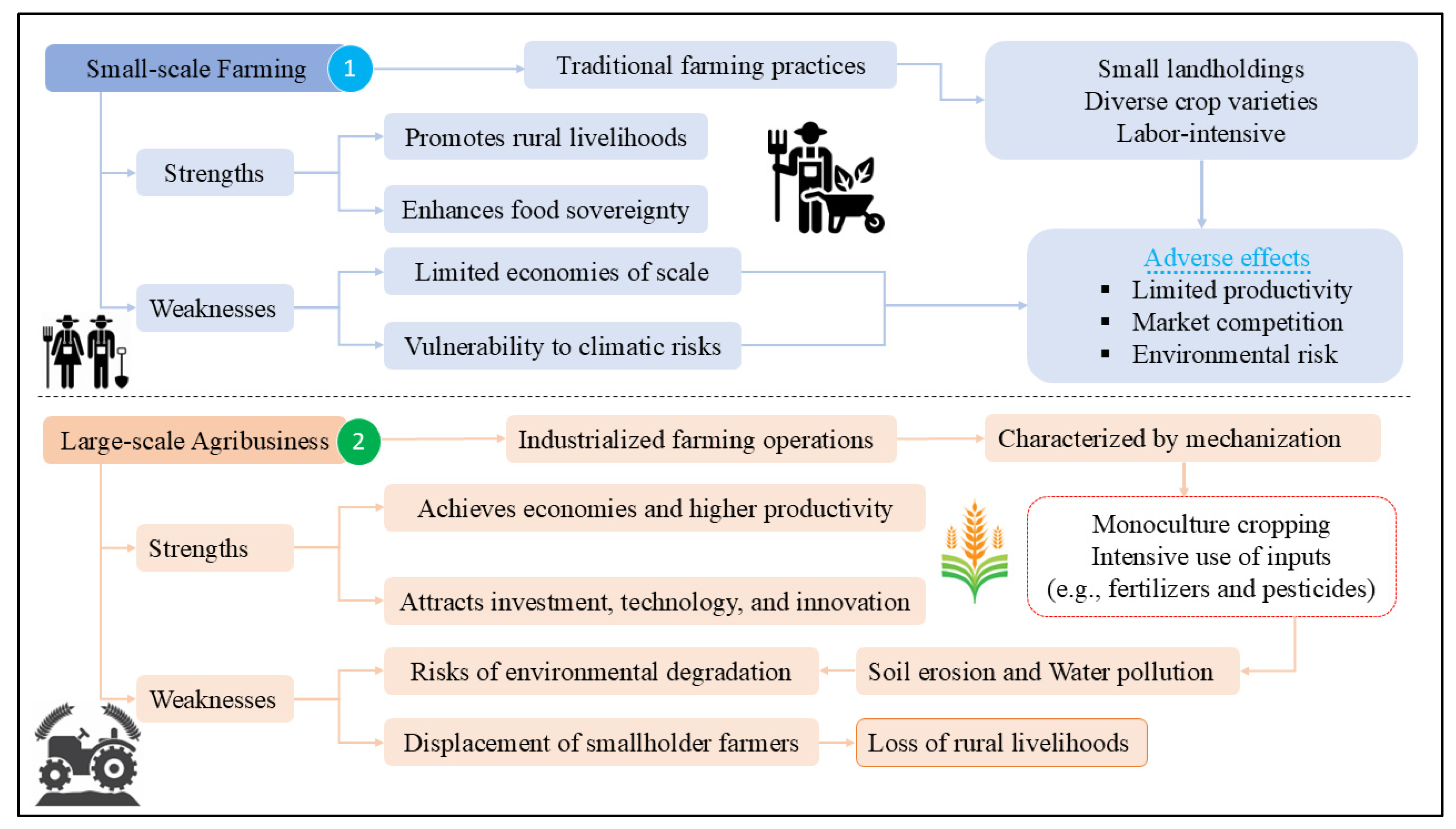
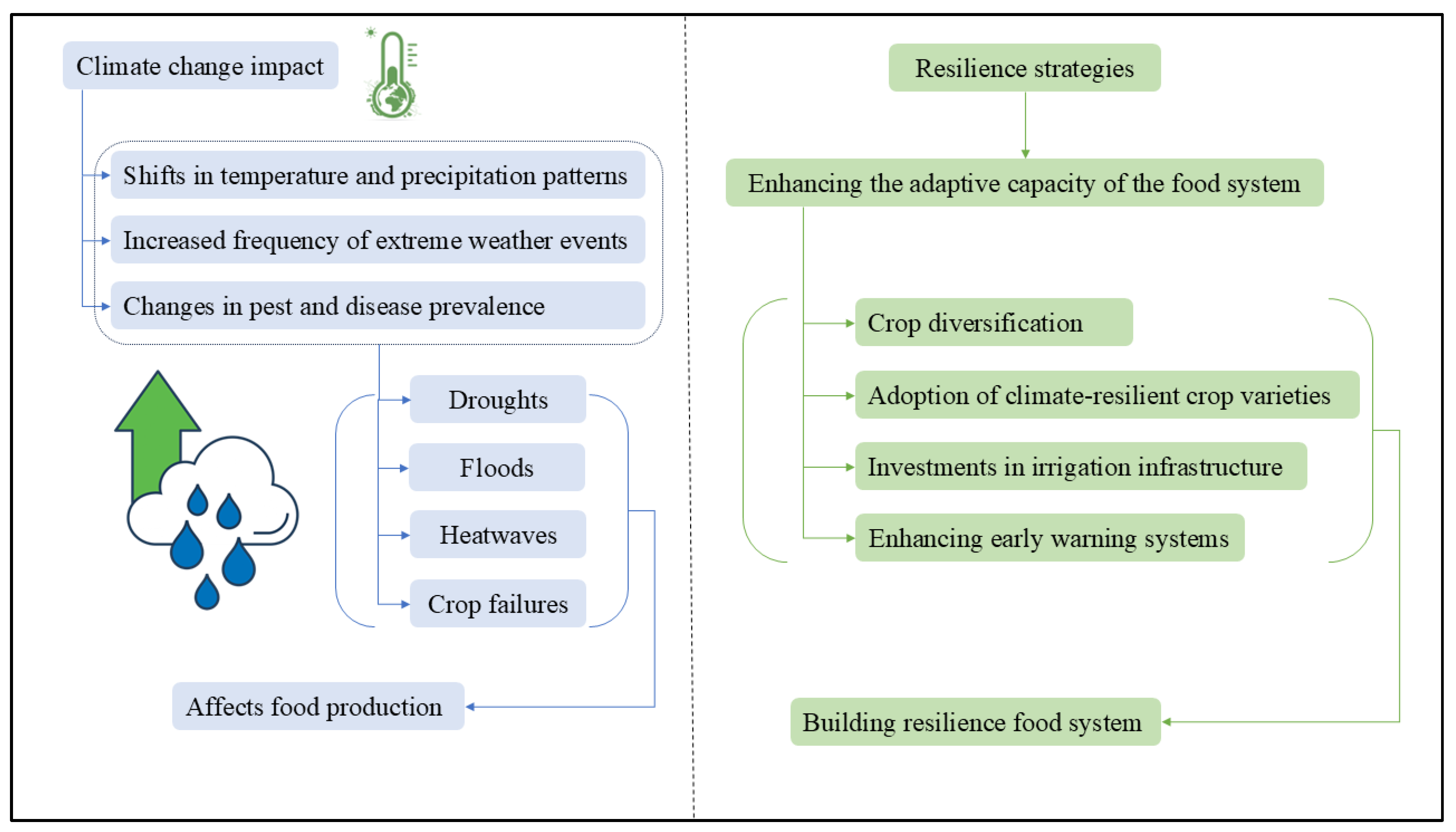
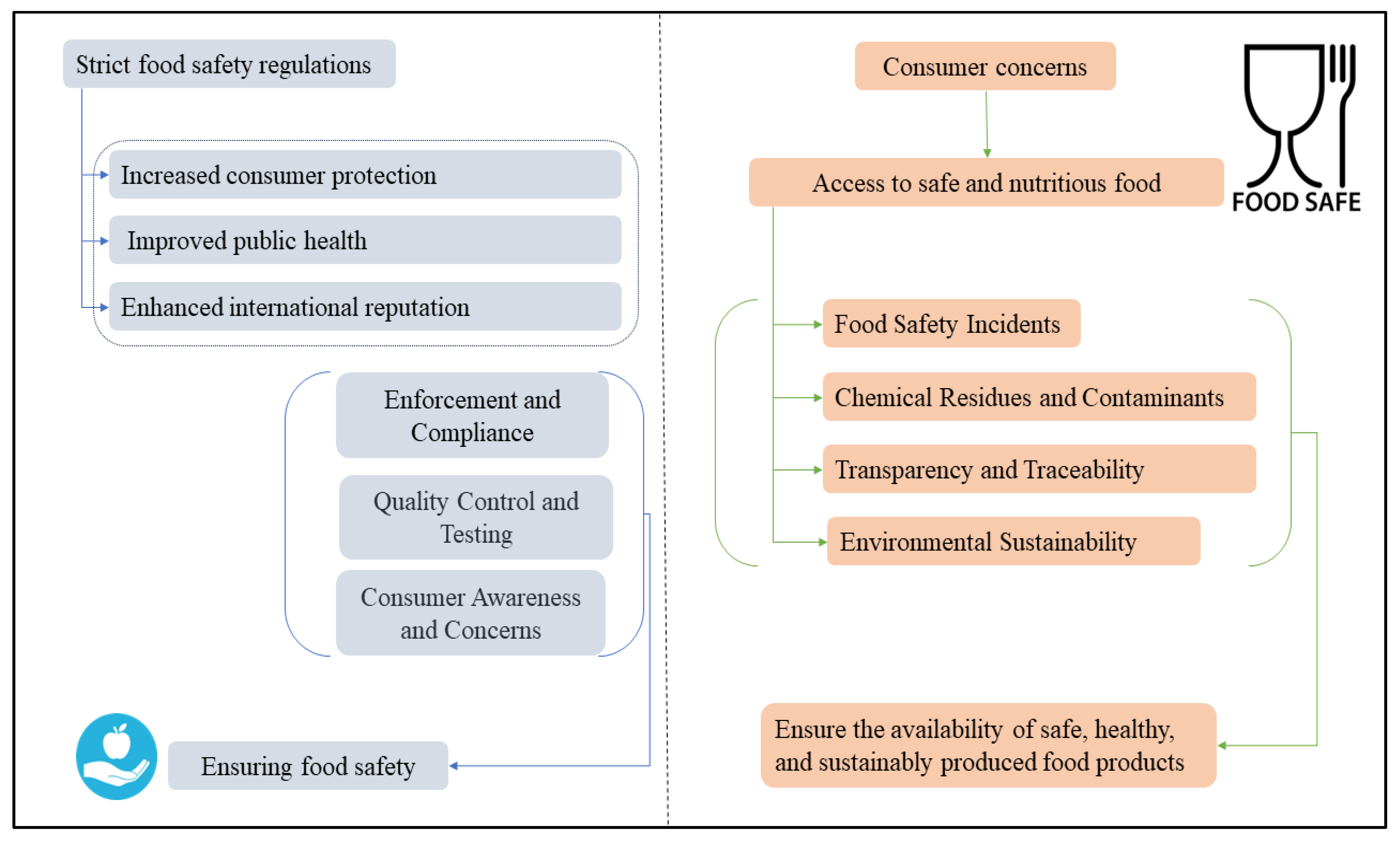
| Policies | Purpose of the Policy | Policy Function | Expected Outcomes | Examples |
|---|---|---|---|---|
| Increasing Agricultural Production | Enhance crop yields Improve overall agricultural productivity | Provide subsidies and incentives for modern agricultural technologies; Invest in infrastructure development (irrigation, rural roads, storage facilities) | Improve resource use efficiency (water, land, etc.) | Grain for Green program to convert marginal land (initiated 1999) Subsidies for high-yield crop varieties and precision farming (Begin-2004; 2021–2025) |
| Expanding Arable Land | Increase the total area of cultivable land Ensure the protection of existing farmland | Strictly limit conversion of agricultural land for non-farming purposes; Initiate land reclamation projects | Protection and expansion of arable land | Farmland Protection policy; Land reclamation projects in western and northern regions (2013) |
| Improving Food Distribution and Logistics | Reduce post-harvest losses Enhance food supply chain efficiency | Develop a nationwide network of grain storage and transportation facilities; Encourage the establishment of modern food processing and distribution centers | Enhanced efficiency of food distribution and reduced waste | Invest in grain storage and transportation infrastructure Promote modern food processing and distribution centers (2021–2025) |
| Promoting Sustainable Agriculture | Maintain soil fertility Reduce environmental degradation | Encourage the use of organic fertilizers, crop rotation, and other sustainable farming practices; Invest in the R&D of climate-smart agricultural technologies | Enhance resilience to climate change | Expand adoption of organic fertilizers and crop rotation Investment in climate-smart agricultural R&D (2022) |
| Diversifying Food Sources | Reduce reliance on imported food commodities Improve food supply diversity | Promote the development of aquaculture, livestock, and poultry production; Encourage the cultivation of alternative crops (oilseeds, pulses) | More diverse and secure national food supply | Expansion aquaculture, livestock, and poultry production Cultivation of alternative crops like oilseeds and pulses (2021–2025) |
| Strengthening Food Security Governance | Coordinate national food security policies Enhance response to food supply disruptions | Establish the National Food and Strategic Reserves Administration; Implement early warning systems and emergency response mechanisms | Improved ability to manage food security and respond to crises | Creation of the national food and strategic reserve administration Development of early warning systems and emergency response mechanisms (2019) |
| Policies | Purpose of the Policy | Policy Function | Expected Outcomes | Examples |
|---|---|---|---|---|
| Green Agriculture Development Strategy (2021–2025) | Promote environmentally friendly agricultural practices | Reduction in chemical fertilizers, pesticides, and use of organic fertilizers | Enhanced environmental sustainability, healthier ecosystems | Integrated pest management, crop rotations |
| Zero Growth Action Plan (2015) | Achieve zero growth in the use of chemical fertilizers and pesticides | Set targets for sustainable usage levels | Reduced chemical input, lowered pollution | Guidelines for minimal use of agrochemicals |
| Ecological Agriculture (2022) | Enhance ecosystems in agricultural production | Promote practices like agroforestry and organic farming | Improved biodiversity, sustainable land use | Agroforestry systems, organic certification programs |
| Soil Pollution Prevention and Control (2024) | Reduce soil pollution from agricultural sources | Control the overuse of chemicals, improve waste management | Cleaner soils, safer food production | Monitoring soil quality, rehabilitation of polluted soils |
| Water-Saving Agriculture (2024) | Improve water use efficiency in agriculture | Modern irrigation techniques, drought-resistant crops | Conserved water resources, improved crop resilience | Drip irrigation systems, usage of drought-resistant crop varieties |
| Agricultural Circular Economy (2021–2025) | Promote recycling and reuse of agricultural waste | Conversion of waste to biogas and organic fertilizers | Reduced waste, enhanced resource utilization | Biogas digesters, composting initiatives |
| Certified Green and Organic Products (2021–2025) | Support production and marketing of sustainable products | Encourage adoption of sustainable practices | Increased market share of green products, better consumer health | Organic certification, eco-labeling |
| Agricultural Non-Point Source Pollution Control (2023) | Reduce pollution from diffuse sources | Implement best management practices | Reduced runoff, improved water quality | Conservation tillage, buffer strips |
| Rural Renewable Energy Development (2024) | Reduce reliance on fossil fuels in rural areas | Support installation of renewable energy technologies | Cleaner energy, reduced greenhouse gas emissions | Biogas systems, solar panels for farms |
| New Rural Construction Program (2022) | Promote sustainable agriculture at village level | Infrastructure improvements, adoption of green technologies | Enhanced rural development, sustainable agricultural practices | Waste management upgrades, introduction of green technologies |
| Agricultural Technology Extension System (2014) | Disseminate knowledge and technologies | Support network of extension services | Increased adoption of sustainable practices by farmers | Farmer training programs, demonstrations of sustainable technologies |
Disclaimer/Publisher’s Note: The statements, opinions and data contained in all publications are solely those of the individual author(s) and contributor(s) and not of MDPI and/or the editor(s). MDPI and/or the editor(s) disclaim responsibility for any injury to people or property resulting from any ideas, methods, instructions or products referred to in the content. |
© 2025 by the authors. Licensee MDPI, Basel, Switzerland. This article is an open access article distributed under the terms and conditions of the Creative Commons Attribution (CC BY) license (https://creativecommons.org/licenses/by/4.0/).
Share and Cite
Zeng, R.; Abate, M.C.; Cai, B.; Addis, A.K.; Derebe Dereso, Y. A Systematic Review of Contemporary Challenges and Debates on Chinese Food Security: Integrating Priorities, Trade-Offs, and Policy Pathways. Foods 2025, 14, 1057. https://doi.org/10.3390/foods14061057
Zeng R, Abate MC, Cai B, Addis AK, Derebe Dereso Y. A Systematic Review of Contemporary Challenges and Debates on Chinese Food Security: Integrating Priorities, Trade-Offs, and Policy Pathways. Foods. 2025; 14(6):1057. https://doi.org/10.3390/foods14061057
Chicago/Turabian StyleZeng, Rong, Meseret C. Abate, Baozhong Cai, Amsalu K. Addis, and Yonas Derebe Dereso. 2025. "A Systematic Review of Contemporary Challenges and Debates on Chinese Food Security: Integrating Priorities, Trade-Offs, and Policy Pathways" Foods 14, no. 6: 1057. https://doi.org/10.3390/foods14061057
APA StyleZeng, R., Abate, M. C., Cai, B., Addis, A. K., & Derebe Dereso, Y. (2025). A Systematic Review of Contemporary Challenges and Debates on Chinese Food Security: Integrating Priorities, Trade-Offs, and Policy Pathways. Foods, 14(6), 1057. https://doi.org/10.3390/foods14061057







